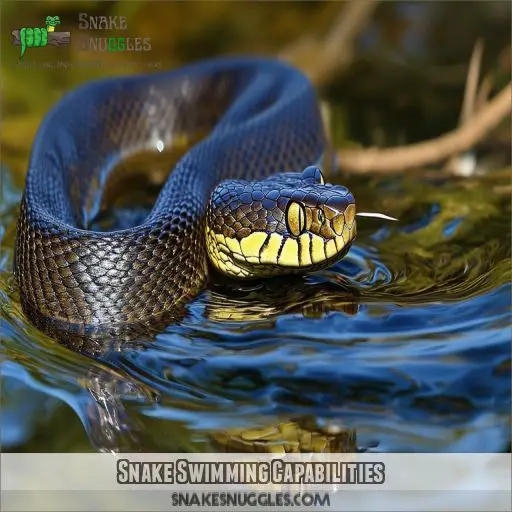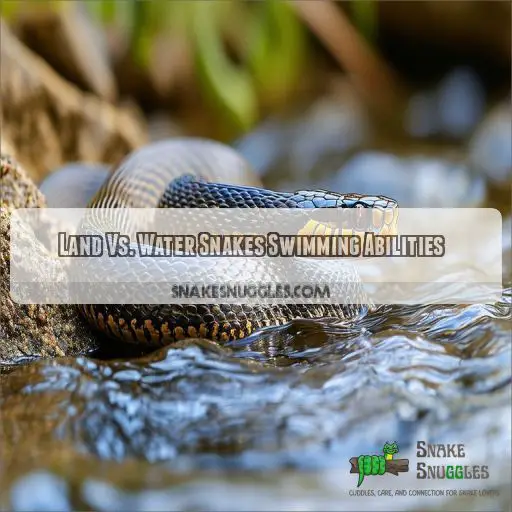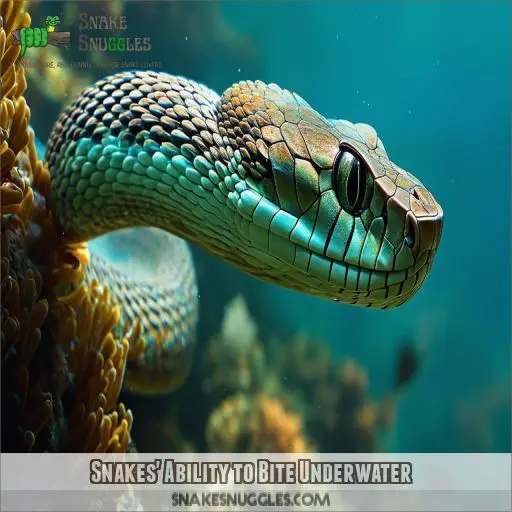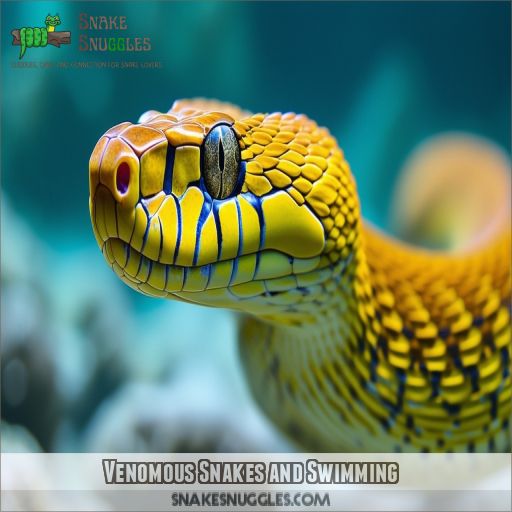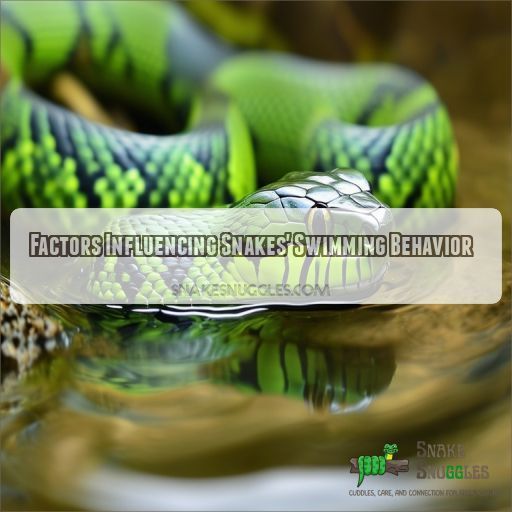This site is supported by our readers. We may earn a commission, at no cost to you, if you purchase through links.

You will be very surprised to learn that, in reality, most snakes can swim; however, there are differences between them. We’ll delve into the fascinating world of serpentine swimming—from the sea snake who masters it to land-dwelling species.
Learn how these reptiles swim and their ability to breathe underwater, along with the ones you are most likely to encounter during your aquatic adventures.
Knowing about snake behavior in the water adds to your knowledge and makes you a safer person.
Table Of Contents
- Key Takeaways
- Can All Snakes Swim?
- Snake Swimming Capabilities
- Types of Snakes That Can Swim Underwater
- Land Vs. Water Snakes Swimming Abilities
- Snakes’ Ability to Bite Underwater
- Duration Snakes Can Stay Submerged
- Venomous Snakes and Swimming
- Factors Influencing Snakes’ Swimming Behavior
- Adapting to Aquatic Environments
- Frequently Asked Questions (FAQs)
- Are there any snakes that can’t swim?
- Can snakes bite you underwater?
- How long can a snake stay underwater?
- Do all snakes like to swim?
- Can snakes swim backwards or only forwards?
- Do snakes use their tongues while swimming?
- How fast can the average snake swim?
- Can snakes drown if caught in strong currents?
- Do baby snakes instinctively know how to swim?
- Conclusion
Key Takeaways
- Holy scales! It turns out all snakes can swim, from slithery sea serpents to desert dwellers. Talk about a surprise – it’s like finding out your cat can do backflips!
- Snakes have some seriously cool underwater tricks up their non-existent sleeves. They can hold their breath for ages, bite underwater, and even use their tongues to "taste" the water. It’s like they’re the Navy SEALs of the reptile world!
- Not all snakes are created equal in the swimming department. Some glide through water like Michael Phelps, while others flail about like a dog in a bathtub. But hey, at least they’re all giving it the old college try!
- Next time you’re taking a dip, remember: that log floating nearby might not be a log at all. Snakes can be sneaky swimmers, so keep your eyes peeled and maybe invest in some snake-proof water wings!
Can All Snakes Swim?
You might be surprised to learn that all snakes can swim. It’s a skill they’ve developed through evolution, adapting to various habitats. Whether venomous or nonvenomous, snakes have the ability to navigate water.
However, not all of them are equal swimmers. Some, like water snakes, prefer aquatic environments and are more adept at swimming. Others may only take to water when necessary.
This universal swimming ability doesn’t mean you should let your guard down, though. Remember, underwater predators can still pose a danger, so it’s best to stay alert near bodies of water.
Snake Swimming Capabilities
You might be surprised to learn that all snakes can swim, but their capabilities vary widely. Some slither gracefully through water, while others struggle. Swimming speeds differ, with sea snakes clocking impressive rates.
Many use camouflage techniques to blend in with their aquatic surroundings. Prey capture methods underwater are fascinating, as snakes adapt their hunting skills. Mating rituals and territory defense also take on unique forms in water.
Remarkably, snakes can bite underwater, making them formidable predators in any environment. From common water snakes to exotic sea kraits, these serpents have mastered the art of aquatic locomotion.
Types of Snakes That Can Swim Underwater
You’ll find that sea snakes and sea kraits are particularly adept at swimming underwater. These marine reptiles have evolved specialized adaptations, such as paddle-like tails and valve-covered nostrils, which allow them to navigate and hunt effectively in aquatic environments.
Sea Snakes
While land snakes can swim, sea snakes take aquatic life to a whole new level. These are some really interesting creatures, which evolved to spend their entire lifecycle in the ocean. Unlike terrestrial cousins of this lineage, sea snakes have flattened, paddle-like tails for efficient swimming and can be submerged for hours. They’re distributed in warm, tropical waters within the Indo-Pacific region.
Sea snakes are highly venomous; a sea snake’s bite may be more potent than that of the cottonmouth or any land snake. Despite this, they give birth to live young right out in the water.
Conservation of these unique serpents is important, as they face habitat loss, changing species compositions, and other challenges associated with climate change, much like other reptiles.
Sea Krait
While sea snakes are fully aquatic, you’ll find sea kraits splitting their time between land and sea. These fascinating creatures are known for their distinctive banded patterns and potent venom.
You’ll spot them in the warm waters of the Indo-Pacific region, from the eastern Indian Ocean to the western Pacific. Sea kraits have adapted to their dual lifestyle, with flattened tails for swimming and cylindrical bodies for land movement.
Their diet mainly consists of eels and small fish, which they hunt in coral reefs. Unlike their fully aquatic cousins, sea kraits must return to land to digest their food, lay eggs, and shed their skin.
Land Vs. Water Snakes Swimming Abilities
While sea snakes excel underwater, you’ll find that land snakes can also swim surprisingly well. Water snakes, naturally, are more adept in aquatic environments. Here’s how they differ:
- Adaptations: Water snakes have streamlined bodies and keeled scales for efficient swimming.
- Habitats: They’re often found near water bodies, unlike most land snakes.
- Behavior: Water snakes are more comfortable spending extended periods in water.
Non-venomous water snakes are often mistaken for their venomous cousins. However, they’ve evolved specific traits for aquatic life. Land snakes, though capable swimmers, typically use water for travel or escape rather than hunting. Their swimming style is less refined, but still effective.
Snakes’ Ability to Bite Underwater
While both land and water snakes can swim, you might wonder about their ability to bite underwater. Surprisingly, most snakes can indeed strike and bite effectively in aquatic environments. Here’s a breakdown of their underwater biting capabilities:
| Snake Type | Bite Force | Underwater Technique | Predatory Tactic |
|---|---|---|---|
| Water Snake | Strong | Quick strikes | Ambush prey |
| Sea Snake | Potent | Specialized fangs | Venom injection |
| Land Snake | Varies | Limited efficiency | Defensive bites |
| Cottonmouth | Powerful | Aggressive pursuit | Opportunistic |
| Anaconda | Crushing | Constriction | Submerge and squeeze |
Understanding these underwater abilities can help you stay safe and appreciate snakes’ remarkable adaptations to aquatic life.
Duration Snakes Can Stay Submerged
You might be surprised to learn that snakes can stay submerged for quite a while. Their respiration techniques** allow them to conserve oxygen, enabling extended underwater stays. Factors affecting submersion duration include:
- Oxygen consumption rate
- Species-specific adaptations
- Water temperature
- Prey availability
Some snakes can remain underwater for up to 30 minutes, using their underwater vision to hunt. During colder months, certain species even hibernate in water, drastically reducing their metabolism. It’s fascinating how these reptiles have evolved to thrive in aquatic environments, isn’t it? Just remember, if you spot a snake swimming, it’s best to give it space and admire from afar.
Venomous Snakes and Swimming
Believe it or not, most venomous snakes are actually very good swimmers. Some, like the water moccasin, have evolved to become aquatic organisms, looking graceful while swimming across their habitat.
This may make it appear as though these types of serpents have a different way of swimming, or that their bodies are doubled over in an S-shape when propelling themselves through the water.
Although dangerous in water, most venomous snakes would rather not attack if given the choice. Their aquatic adaptations aren’t only for hunting but, more importantly, for escaping danger.
Factors Influencing Snakes’ Swimming Behavior
Several factors influence a snake’s swimming behavior, including its physical adaptations, habitat, and species-specific abilities. You’ll find that snakes with streamlined bodies and flattened tails are more adept swimmers, while those living near water bodies have developed better aquatic skills compared to their land-dwelling counterparts.
Physical Adaptations For Swimming
You’ll find snakes equipped with remarkable physical adaptations for swimming. Their hydrodynamic body shape reduces water resistance, while their muscular bodies enable powerful propulsion methods.
Snakes employ unique swimming techniques, using lateral undulations to glide through water effortlessly. They’ve mastered buoyancy strategies, adjusting their lung inflation to control depth.
With their streamlined form and underwater maneuverability, these serpents navigate aquatic environments with surprising ease, showcasing nature’s ingenious design for life in water.
Habitat And Environmental Conditions
Beyond the physiological anatomy, the ability of any snake to swim is influenced to a great extent by the environment.
You’ll find the temperature of the water affecting their respiration and general activity. Prey availability may attract snakes in aquatic habitats, while predator avoidance may drive them to seek refuge in water.
Some snakes also use water for buoyancy purposes, thereby saving energy during prolonged swimming. This gives a fine balance between their survival and their opportunities in this watery world.
Species-Specific Swimming Abilities
Indeed, very often one can infer the preferred habitat and evolutionary history of any one snake species from its swimming behavior.
Serpent buoyancy ranges wildly from gliding effortlessly through water to sprawling upon the same liquid.
Then there’s the undulating S-pattern motion corresponding to the side-to-side movement of terrestrial snakes, contrasted with the vertical undulations of sea snakes.
Aquatic predators developed flattened tails and other special adaptations that enabled them to improve their underwater performance.
Such is the great diversity of slithering swimmers!
Adapting to Aquatic Environments
You will be amazed how water snakes have adapted themselves through the ages to aquatic conditions. Their bodies have streamlined and their scales have become specialized for swimming.
Slithery swimmers have developed unique swimming techniques which help them glide effortlessly through water.
Where aquatic snake reproduction is concerned, many species have evolved to give birth to live young as opposed to laying eggs.
It’s not difficult to imagine underwater hunting for these serpents, some even having venom to subdue prey. Don’t be fooled, though—not all water snakes are venomous.
It’s just amazing. That’s a whole different world down there!
Frequently Asked Questions (FAQs)
Are there any snakes that can’t swim?
You’ll find that all snakes can swim, but their abilities vary. Some are natural swimmers, while others struggle. Even desert-dwelling species can manage in water, though they’re not as adept as their aquatic cousins.
Can snakes bite you underwater?
Yes, snakes can bite you underwater. Their quick reflexes and ability to strike remain intact, even in aquatic environments. You’re not safe from a snake’s bite just because you’re submerged, so always exercise caution around water-dwelling snakes.
How long can a snake stay underwater?
You’ll be surprised to learn snakes can stay underwater for impressive durations. Some species can hold their breath for up to 30 minutes, while others manage a few hours. It’s a remarkable adaptation that aids their survival in aquatic environments.
Do all snakes like to swim?
Not all snakes enjoy swimming. While they’re capable of it, some prefer dry land. Water snakes and certain species love aquatic environments, but others, like desert dwellers, avoid water. It’s a matter of adaptation and preference.
Can snakes swim backwards or only forwards?
Like a submarine moving under the water, snakes swim mostly forward. They aren’t constructed to swim backwards. Their body frame and muscular system are both tailored for the propulsion of the body forwards through the water, so you’ll hardly see a snake swimming in reverse.
Do snakes use their tongues while swimming?
You’ll notice snakes use their tongues while swimming, just as they do on land. They flick their forked tongues to gather chemical cues from the water, helping them navigate and detect prey or predators.
How fast can the average snake swim?
You’ll find the average snake swims at 1-2 mph, though speeds vary by species. Some, like sea snakes, can reach 6-7 mph. Factors like body size and water conditions affect their swimming speed.
Can snakes drown if caught in strong currents?
Like fish out of water, snakes can drown in strong currents. You’d be surprised, but these slithery swimmers aren’t invincible. If caught off guard, they’ll struggle to breathe and may succumb to the water’s relentless force.
Do baby snakes instinctively know how to swim?
You’ll be amazed to learn that baby snakes are natural swimmers from birth. Their instincts kick in immediately, allowing them to navigate water effortlessly. It’s like they’re born with tiny life jackets – nature’s way of ensuring their survival.
Conclusion
As you delve deeper into the world of serpentine swimming, it will be a discovery that most snakes do swim approximately like they move on land. Not all snakes are aquatic experts, but many species have mastered swimming and terrestrial locomotion.
Just knowledge of their swimming prowess, breath-holding capacity, and behavior in an aquatic environment allows you to cope better and enhance your safety.
Whether you’re walking beside the coast or exploring inland waterways, remember that some snakes occupy these same habitats. Now, armed with that knowledge, you can appreciate these amazing animals while keeping a safe distance.

